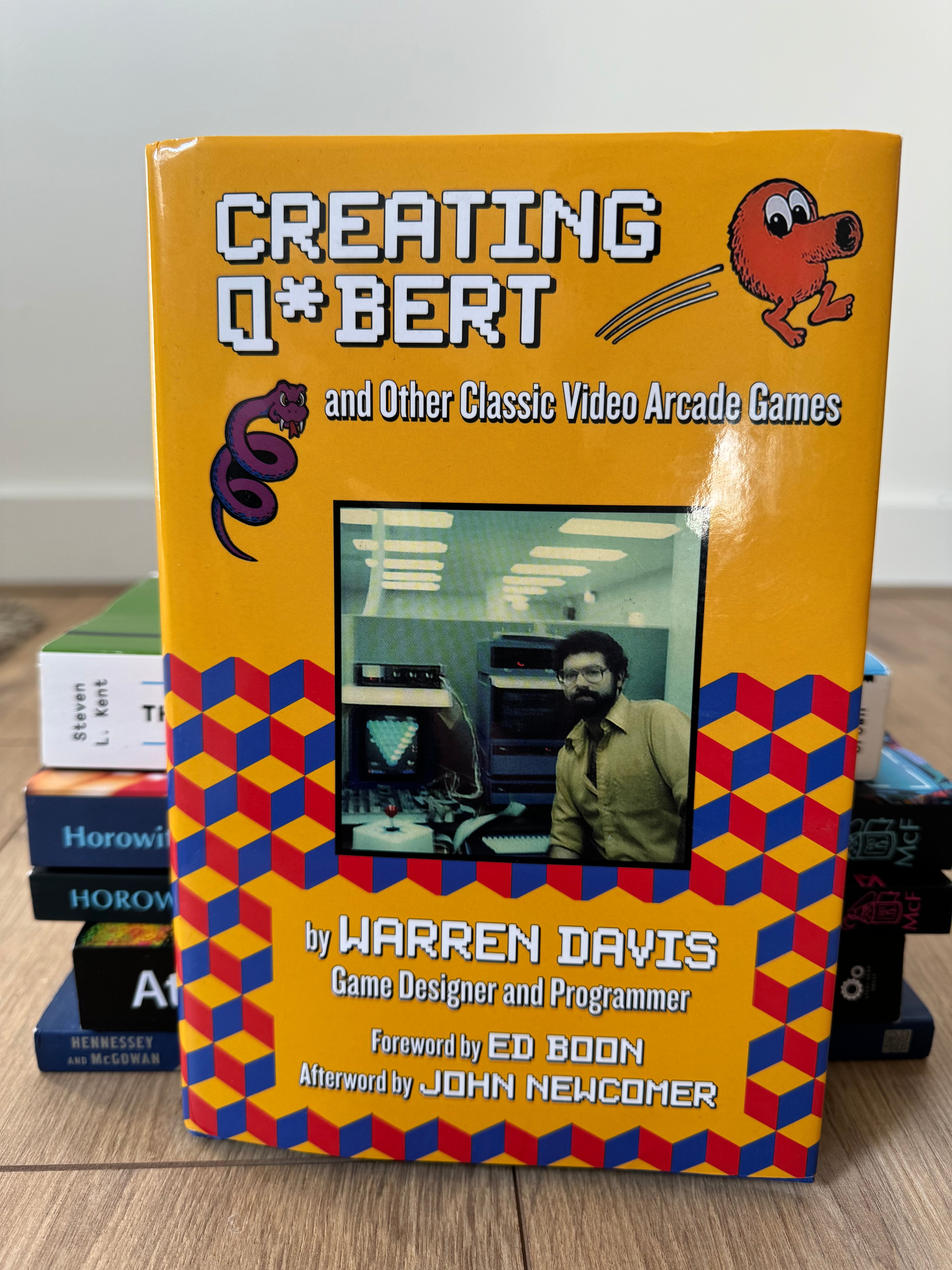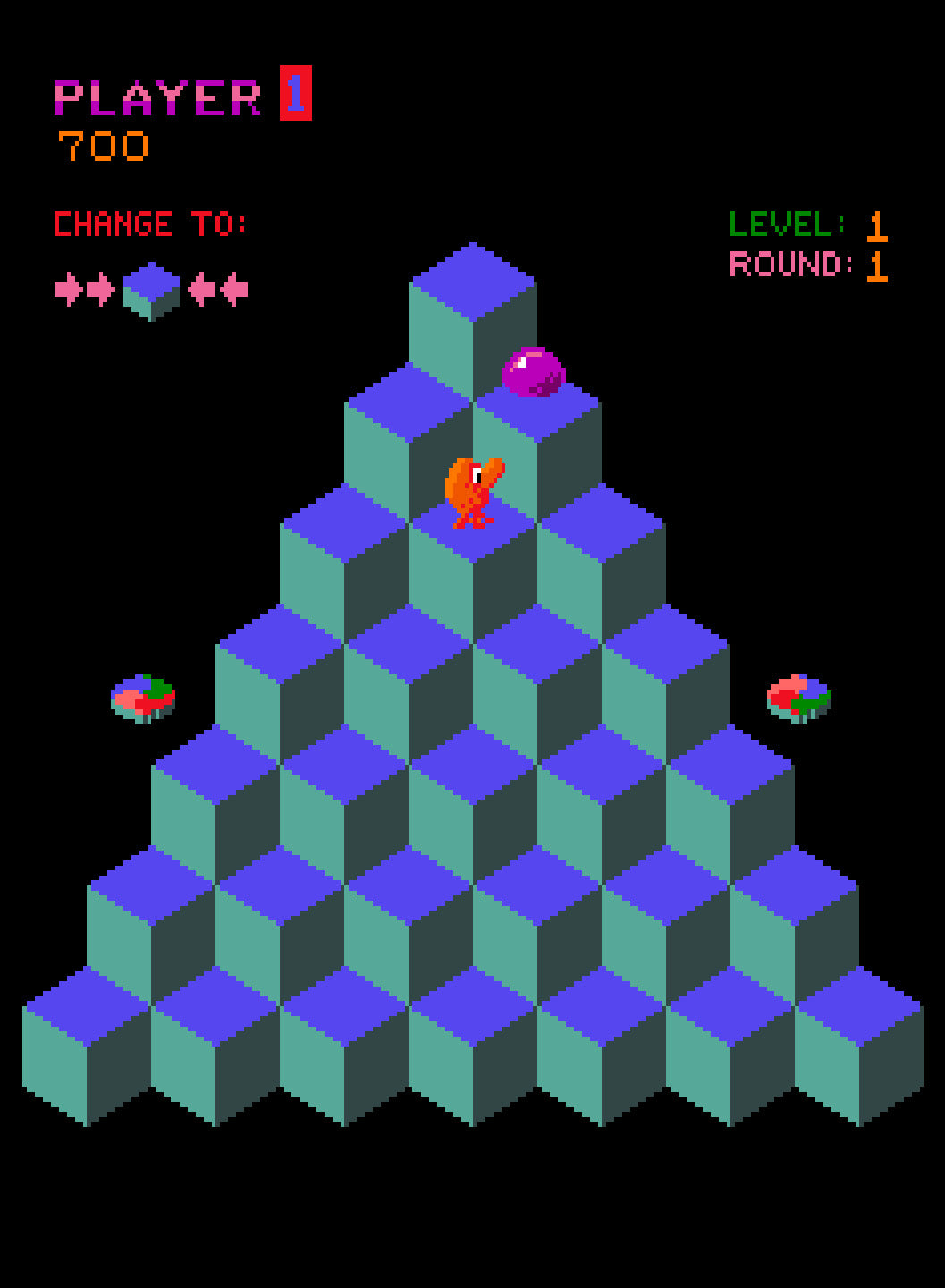Introduction: An Orange Icon Rises
In 1982, amid a flood of space shooters and maze chasers, a foul-mouthed orange creature bouncing on cubes took arcades by storm. Q*bert didn’t fire lasers, eat pellets, or pilot a ship. Instead, he hopped. And cursed. And fell off ledges to the sound of a loud thunk inside the cabinet.
It wasn’t just the gameplay that stood out. Q*bert was strange. Surreal. Even charming. It fused quirky design, oddball audio, and deceptive difficulty into one of the most beloved arcade experiences of the golden age.
But like many classics, Q*bert’s path to stardom was neither planned nor polished. It was a design experiment, a series of what-ifs. And it almost didn’t happen.
This is the true story of Q*bert: from the M.C. Escher-inspired cubes to the randomized swearing, and the team of newcomers who built one of the most unforgettable games in arcade history.

1. Born from Cubes: Jeff Lee and a Visual Spark
The story of Q*bert began not with a game concept, but with art.
"Being a fan of the great Dutch artist M.C. Escher, the master of optical illusions, I constructed a stack of triad-based cubes. Admiring my derivative handiwork, it struck me, there's a game in here somewhere!"
—Jeff Lee, The Ultimate History of Video Games
Artist Jeff Lee imagined a game world based on isometric cubes. His prototype was abstract: a screen filled edge to edge with Escher-style blocks. When programmer Warren Davis saw it, he immediately saw a problem—and a solution.
"Warren saw this stuff that Jeff Lee was working on, these shaded cubes that filled his screen, and asked if he could have a copy of the art. He started playing with it and said, 'You know, the problem with this is that it shouldn't cover the screen like this.' So he made a pyramid out of it."
—David Thiel, The Ultimate History of Video Games
The visual pyramid became Q*bert's stage. Enemies, rules, and gameplay came later.

2. Gravity, Trigonometry, and Nose Bullets
At first, Q*bert was going to shoot from his nose.
"As much as I liked the goofiness of that idea, I really didn’t see any need for shooting anything at this point."
—Warren Davis, Creating Q*bert
Ideas flowed and changed rapidly. One early mechanic involved enemies who walked on the sides of cubes, each with their own gravitational direction.
"I couldn't begin to fathom how to make the physics work without trigonometry or other advanced math functions that we just didn't have the power to compute... But for some reason, the idea stuck in my head. Damn that Jeff Lee!"
—Warren Davis, Creating Q*bert
It was Davis's first game. He was humble, cautious, and hungry to make something different.
"Having never designed a video game before, I wasn't so arrogant as to think I could be an expert at it immediately."
—Warren Davis, Creating Q*bert
The idea that stuck: a character who changes cube colors by landing on them. And enemies who try to stop him.

3. Meet the Cast: Coily, Slick, and the Mystery of Hubert
Every good arcade game needs enemies, and Q*bert's were as eccentric as the game itself. The coiled snake became Coily, the main pursuer.
"Coily was an obvious choice for our coiled snake. The names Slick and Sam, given to the green creatures who worked against the player by turning cubes back from their target color, was a play on the phrase 'spick-and-span'."
—Warren Davis, Creating Q*bert
Even the title of the game was uncertain. For a while, it was simply called "Hubert."
"Why Hubert?” We all asked. "Well, it’s a name. And it seems to suit the character. Plus it sounds like 'cube' and the game is about cubes."
—Warren Davis, Creating Q*bert
Hubert became Q-Bert. Then Q*bert. A quirky name for a quirky game.
4. Swearing in Alien Tongue: Birth of a Catchphrase
One of Q*bert’s most memorable elements is his garbled speech bubble—"@!#?@!"—whenever he gets hit.
That wasn’t scripted. It was pure experimentation.
"He decided to just throw random numbers at the Votrax and see what would happen. The result is the gibberish that became Q*bert’s voice."
—Warren Davis, Creating Q*bert
The Votrax SC-01A speech chip was notoriously limited. Sound engineer David Thiel tried to make it say phrases, but the results were often nonsense.
"We wanted the game to say, 'You have gotten 10,000 bonus points,' and the closest I came to it after an entire [day] would be 'bogus points.'... I said, 'Well, screw it. What if I just stick random numbers in the chip...?' It sounded alien. It sounded like somebody should be able to understand it, but, of course, you couldn't."
—David Thiel, The Ultimate History of Video Games
And just like that, Q*bert's signature expletive was born.

5. Hardware Tricks and Immersion Knocks
The Q*bert cabinet did something no arcade game had done before: it made a real thump when Q*bert fell.
"I wrote the code to trigger the knocker at the proper time, and… magic! It sounded perfect. It drew the reality of the game off the screen and into the real world in a very fun way."
—Warren Davis, Creating Q*bert
Originally, they considered using foam to simulate the sound of a body hitting the floor. It was too expensive. So a pinball knocker was wired into the cabinet. Players heard and felt the impact.
6. Difficulty, Earnings, and the FMHC Panic
On test locations, Q*bert did well—but not perfectly. Some worried it was too hard.
"The memory of people at Gottlieb telling me the game was too hard crept into my brain... Was I wrong?"
—Warren Davis, Creating Q*bert
But Davis soon learned the opposite could be worse. Some players were playing for hours on one quarter.
"Within a few weeks, reports filtered in about some people playing the game for hours on one quarter. One Quarter! My worst fears had been realized!"
—Warren Davis, Creating Q*bert
Long play sessions meant fewer coins. Davis feared the game would be pulled from arcades.
"I panicked, thinking if I didn’t take immediate action the game would die a quick death."
—Warren Davis, Creating Q*bert
The solution? An enhancement kit: Faster, Harder, More Challenging Q*bert.
But there was another trick.
"The dirty little secret of Q*bert is that the tuning actually doesn’t change after Level 5. That’s right—Levels 6 through 9 and beyond are all simply re-using the same tuning tables for Level 5. The reason for this was simple: I didn’t think anyone would ever play that far on one quarter!"
—Warren Davis, Creating Q*bert

7. Legacy: From Saturday Cartoons to Mortal Kombat
Q*bert was a hit. Merch, toys, and even a Saturday morning cartoon followed.
"The most surreal event I experienced, though, was seeing the little noser in a Saturday morning cartoon series."
—Warren Davis, Creating Q*bert
It wasn’t quite Pac-Man or Donkey Kong in terms of global reach. But for a time, Q*bert was everywhere.
"Perhaps in total Q*bert didn't achieve quite the level of success as Pac-Man or Donkey Kong. But for a brief, shining moment Q*bert was everywhere."
—Attract Mode
And its creators went on to shape gaming’s future.
"Q*bert may be Warren's most famous creation, but his work at 1990's Midway was instrumental in the parade of arcade smash hits that marched out of our studio."
—John Tobias, Creating Q*bert
"I can't overstate the impact Warren had on the development of Mortal Kombat and so many other Williams/Midway games."
—Ed Boon, Creating Q*bert
Even today, Warren Davis remains proud. Though he never received royalties—"Most people who meet me think I had some financial stake in Q*bert... Unfortunately, that's just not the case"—he did get a $20,000 bonus.
"It was a huge chunk of money for me, and I was extremely grateful."
—Warren Davis, Creating Q*bert

Conclusion: The Genius of Accidents
Q*bert wasn’t supposed to be iconic. It wasn’t supposed to curse, or knock, or climb pyramids. It began as abstract art, twisted into gameplay by trial and error, and given life through tech limitations.
It was, in the best way possible, an accident. A happy, gibberish-shouting, gravity-defying accident. And that’s what made it timeless.
Sources & Further Reading
- Warren Davis, Creating Qbert* (2021)
- Steven Kent, The Ultimate History of Video Games (2001)
- Jamie Lendino, Attract Mode: The Rise and Fall of Coin-Op Arcade Games (2017)
- Horowitz, Ken. From Pinballs to Pixels: The Arcade Video Game Revolution (2023)
Want to Go Deeper Into Arcade History?
If this Q*bert article left you craving more, dive into the complete stories behind some of the most iconic arcade genres and franchises. These articles explore the rise, innovation, and legacy of the games that shaped arcade culture:
- Donkey Kong’s Rise to Fame: How a Desperate Bet Created a Gaming Legend – The untold story of how Nintendo turned failure into a global icon, launching Mario, Miyamoto, and a new era of arcade storytelling
- What Makes an Arcade Game Great? – A deep dive into the design principles behind the most unforgettable cabinets of all time
- Inside the Metal Slug Legacy: The Developers Who Made It a Classic – How a small team at Nazca crafted one of the most iconic run-and-gun series of all time.
- The Complete History of Mortal Kombat Arcade – How a gritty fighter became a pop culture phenomenon.
- Capcom’s 19XX Series: The Complete History – The vertical shooters that defined a generation of arcade firepower.
- The History of Beat ’Em Up Arcade Games – From Double Dragon to Final Fight, here’s how brawlers ruled the late ’80s.
- The Complete History of Space Shooter Arcade Games – The genre that launched arcades into orbit.
- The King of Fighters Legacy: Inside SNK’s Genre-Defining Saga – How SNK’s 3v3 fighter evolved from a crossover gamble into one of the deepest and most beloved fighting franchises in the world.
- Defender: The Game That Changed Everything – How a risky bet and a radical vision helped redefine arcade design forever.

